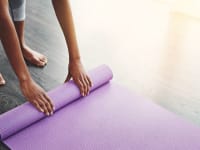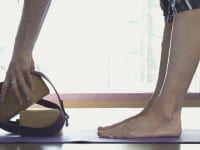It's not just for wine bottles: how cork makes a sweaty yoga session easier
This springy mat could upgrade your practice.
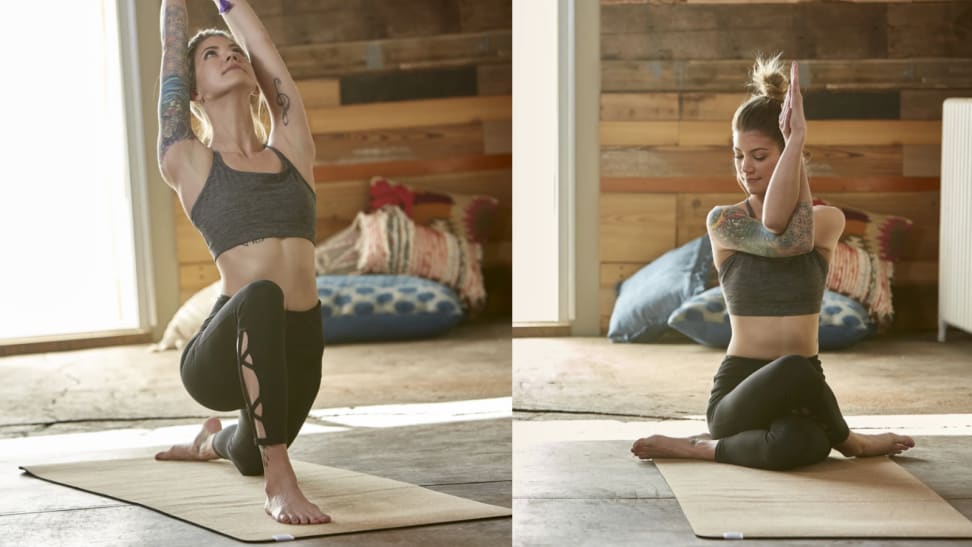 Credit:
Gaiam
Credit:
Gaiam
Products are chosen independently by our editors. Purchases made through our links may earn us a commission.
You can do yoga anywhere—in your living room, at the beach, in the park, at a studio—and you don’t necessarily need a fancy mat. However, anyone who does yoga regularly will tell you that the mat they use has an effect on their practice. Yoga mats made from different materials give you varying amounts of stability, balance feedback, and support in poses. As a yoga teacher, I’ll admit I’m picky when it comes to the mats I like to practice on.
I’m a longtime fan of the $90-ish Lululemon 5mm Reversible Yoga Mat, which is made of layers of polyurethane and natural rubber. But lately, I’ve noticed more people bringing cork mats to the yoga studio, so I decided to try out the $40 Gaiam 5mm Performance Cork Yoga Mat for myself to see if it was worth the switch.
What is a cork yoga mat?
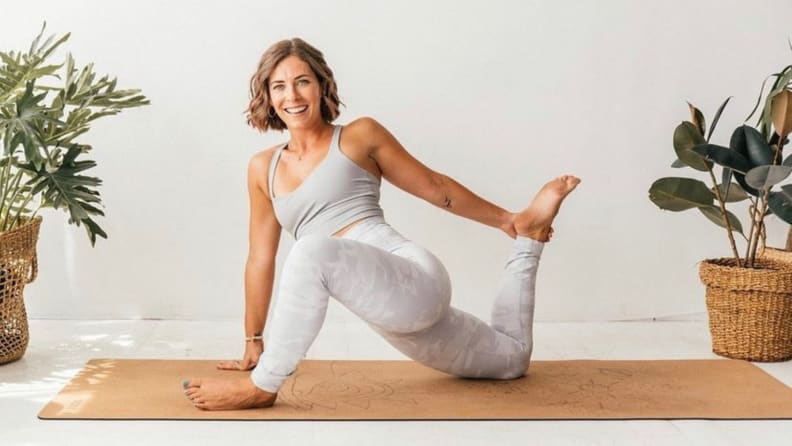
Most cork mat manufacturers make eco-friendly claims.
Most yoga mats are made of natural rubber or synthetic plastic foams made of PVC or TPE, i.e., thermoplastic elastomers, a type of plastic foam that has similar attributes to rubber. But a cork yoga mat is made with, well, cork—a natural material derived from a layer of bark from cork oak trees.
In mat form, the cork used feels much smoother than other cork products, like yoga blocks or wine stoppers. It has a denser feel than other mat materials, so some mats feature cork on one side and rubber or TPE foam on the other, for superior cushioning and support for sensitive knees. Most brands claim the natural cork used in their mats is eco-friendly and sustainably sourced and seek out certifications from organizations such as OEKO-TEX and Fair Rubber Association (if the mat uses rubber as a base). The Gaiam mat I tested is made of cork with a lightweight TPE base bound to the cork surface, which makes it cheaper than rubber-bonded mats and safe for people with latex allergies.
As a material for yoga mats, cork is lightweight yet durable, easy to clean, and naturally antimicrobial, which means it resists germs and odors and is important for sweaty classes and mat storage. Cork also does not absorb dust, which could make it a good mat alternative for people with allergies and skin sensitivities.
You can find cork yoga mats from brands other than Gaiam such as Everyday Yoga, Yoga Design Lab, and Yoloha Yoga.
How does the Gaiam cork mat compare to a regular yoga mat?
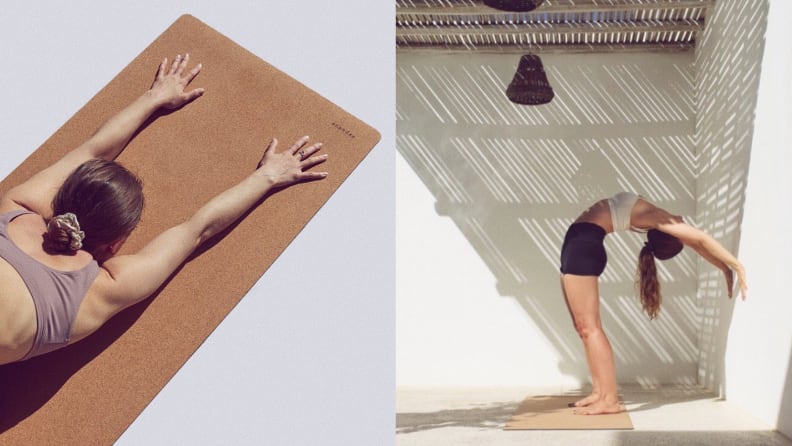
Cork mats don't get as smelly or scratched up as others tend to.
The Gaiam mat I tried is about the same size and thickness as many yoga mats, at 68 inches long, 24 inches wide with a 5mm thickness, but it's not oversized like my 71-inch by 26-inch Lululemon mat. The cork mat feels a lot lighter at 4.5 pounds, though it actually only weighs a little less than Lululemon's 5.24 pounds.
Like most cork mats, Gaiam claims its composition carries antimicrobial properties and can withstand even the sweatiest of practices and repels germs and odors, unlike other mats that absorb them. Gaiam did not seek out environmental certifications, but it claims the mat's cork is sustainably sourced.
The cork mat works almost the opposite way a rubber mat does in terms of handling humidity and sweat. Most rubber mats begin to get slippery in hot yoga classes, so you need a mat towel to absorb moisture so you can maintain your grip. The cork mat actually felt slippery to me when dry and became better to grip as it got wetter.
What I like about the Gaiam cork mat
No weird odor out of the box
One thing immediately jumped out at me when I took my mat out of its box: There was no odor at all. The rubber-based mats I’ve used, including the Lulu mat, have a distinct tire-like smell that takes days (even weeks) of airing out to fade away. I loved that the cork mat didn’t have any funky scent to it, because it made me want to use it immediately.
The springy cushioning
The second thing I noticed, after the smell (or lack thereof), was the mat’s springy texture. The Gaiam mat arrived rolled up so tightly that I worried it might lack the buoyancy I'm used to. However, it maintained a pleasant amount of bounce during the time I used it. I stored the mat rolled up on one end and left it lying flat on the floor, and the mat sustained its cushioned surface throughout. This texture also helps it feel supportive, which I love in poses like table and downward dog. I haven’t had any issues with the mat slipping on my floor, either, thanks to the TPE underside.
Its ability to look less dirty
I also didn't feel the need to wipe down my cork mat as often as my Lulu mat. During my testing period, I left both mats side by side on my floor for two days and played around on both throughout the day—I like to take stretch breaks as I work—to see how they held up to frequent use. After, I noticed that the Lulu mat collected more dust than the cork mat. This doesn't mean the Gaiam mat actually was that much cleaner; more that its brown color and textured surface likely just means it shows less grime than the Lululemon mat's smoother, somewhat tacky polyurethane top layer.
But if you get skeeved out by the visible specks of dust that tend to gather on traditional mats, you may like a lower maintenance mat that doesn't always remind you it needs to be wiped off. For its part, Gaiam recommends spot cleaning the cork mat with its specialized yoga mat wash or a damp cloth, cold water, and mild detergent.
What I don't like about the Gaiam cork yoga mat
The slippery-when-dry surface
As mentioned, the cork surface is slippery when it’s dry. Because I don’t do many hot yoga classes, nor do I sweat heavily during my regular flows, most of my practice involved frequently repositioning my hands and feet to remain stable. Once I realized this, I sprayed water on the mat where my hands and feet go as I started my practice—and the mat was easier to use from the get-go.
If you don’t get super sweaty when you practice, I’d recommend getting a spray bottle and doing the same, at least while you’re getting used to the mat. The downsides: My clothes wet when I was kneeling or lying down in poses, and it took two to three hours for the mat to dry off after use. (The Gaiam site recommends letting the mat dry while lying flat as opposed to rolled up, too.)
The wrinkles that didn’t flatten out
I also noticed the mat also shows wrinkles and fold lines long after the mat is laid flat. This isn’t a big deal to me but may bother some who like their mats to look impeccably sleek (the Lululemon mat, for example, never wrinkles, even though it can pick up dirt). The lines on the Gaiam cork mat don’t impact my practice, but they are noticeable and worry me about its durability over time.
The mat’s refusal to stay rolled
My final issue with the mat is that it doesn't stay rolled up on its own, which proved frustrating—and could be even more annoying to anyone who wants to travel with it or just take it to a yoga studio for class. After a few tries to keep it coiled up, I grabbed a string and looped it around the mat to keep it from unrolling yet again. You can also get a yoga mat sling to keep it tidy and easier to carry if you know you’re going to take it with you on the go.
Is the Gaiam cork yoga mat worth it?
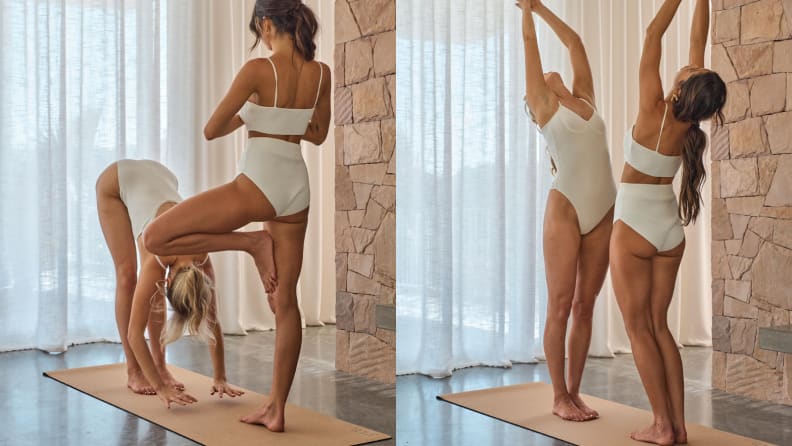
Yin Yoga Mats are eco-friendly and have beautiful patterns.
Yes, if you practice a lot of hot or sweaty yoga
If you enjoy hot yoga, live in a humid or hot area, or just sweat a lot, there’s a good chance you'll like the cork material and qualities. Cork is a natural material with a long lifespan and potential for upcycling, recycling, and biodegrading, so it’s a good option for eco-friendly yogis.
As for me, I’ll opt for the cork mat when I take a hot yoga class or an outdoor class in the summer. But I'll stick with my Lululemon The Reversible mat 5mm for when I’m teaching and practicing, because I don’t sweat much and prefer the polyurethane top material’s inherent grippy feel.

